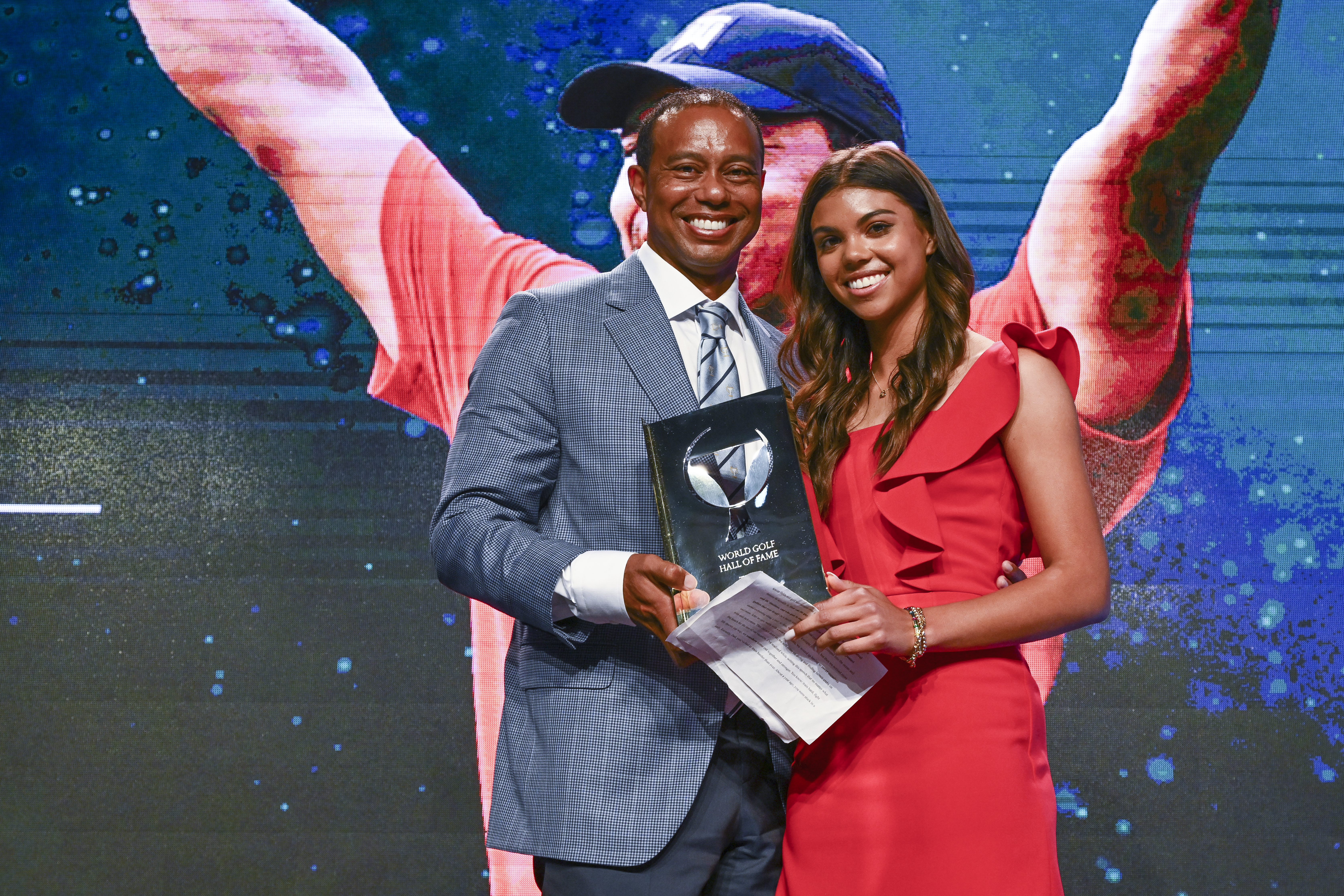Much of Tiger Woods’ World Golf Hall of Fame induction speech sounded like it could’ve been written for an audience of two – his teenaged kids, Sam and Charlie.
Woods went “retro” as he called it, telling delightful and meaningful stories from his childhood in a 17-minute speech that came from the heart rather than the teleprompter. Woods mostly told family stories. Many were relatable. Some were extraordinary. None involved a major championship.
All helped lay the foundation of the most impactful player the game has ever known.
Too young to play as a dependent at the Navy Golf Course in Long Beach, California, a 6-year-old Woods played in Saturday tournaments at Heartwell Golf Park, a local par-3 course. Woods said he spent the week preparing at the park down the street with his dog Boom-Boom, named after Fred Couples.
“I’d hit balls in the dark, in the grass, through trees, in the sand, through the hula hoops, everything,” said Woods. “So my dog, I’d only hit two golf balls. He would go lay down next to each one of them. Well, that’s kind of how I learned to play the game of golf.”
By age 8, Woods had learned how to turn the 75 cents his mother had given him to buy a hot dog and call home into a profit. Once his father, Earl, noticed that he started coming home with extra quarters in his pocket, Tiger was told no more putting contests for quarters.
“Fine, done, I won’t putt for any more quarters,” Woods told his father.
The next week he came home with a pocketful of dollar bills.
After promising that he wouldn’t putt for money again, Woods once again came home with a wad of cash.
“He said, ‘I thought I told you never to putt for money again,’ ” recalled Tiger. “I didn’t. I went out and played skins.”
From age 8 to 10, Woods would sneak onto the Navy Golf Course after his father got off of work just after 4 p.m. Woods’ mom would drop him off at the entrance of the course, and he’d make his way down what they called “The Ditch,” picking up golf balls until his dad came riding up on the third hole.
“So I would sneak down the first hole to the second hole,” said Woods, “but dad taught me how to always grab a piece of foliage, cover yourself up, listen for noise. If you hear anybody coming, lay still (laughter). Part sniper.”
In the wintertime, darkness would close in fast and Earl had a rule that if someone lost a ball, it was time to drive in.
“Part of understanding how to shape shots and knowing where I hit it on the face, where I would hit it all started then,” said Woods. “So if I hit it, Dad, I pulled it left, it’s up the left side, it’s going to be here. We’d drive there, it’s there, we can continue playing. The furthest I ever made was 17 holes in the dark. Never quite got to 18.
“One of the things that drove me was his passion to play the game of golf. I was never going to be denied to play. I loved it. I had this burning desire to be able to express myself in this game of golf.”
Woods, who named his son after Charlie Sifford, the first Black member of the PGA Tour, said his father instilled in him the need to be twice as good to be given half the chance. It’s the reason why Tiger made practice so difficult it hurt.
As he got older, junior tournaments put on by the Southern California Junior Golf Association took the eager youngster to courses that had “CC” in the title for country club, which for Woods translated to an upgraded experience with fresh greens.
But Woods said not all of those clubs welcomed him because of the color of his skin. As he got older, those prejudices drove him even more.
“So as I was denied access into the clubhouses, that’s fine,” said Woods. “Put my shoes on here in the parking lot. I asked two questions only, that was it. Where was the first tee, and what was the course record. Not complicated.”
Woods also touched on the financial hurdles his family faced, noting that when he was 14 ½ and wanting to compete on the AJGA, his family took out a second mortgage. The 46-year-old, 15-time major champion got emotional as he talked about his parents’ sacrifices and the work ethic they instilled.
When Woods turned pro, he immediately used the sponsorship money from Nike and Titleist to pay off his parents’ mortgage.
“I know that golf is an individual sport,” said Woods. “We do things on our own a lot for hours on end, but in my case, I didn’t get here alone.”
Before Woods pulled back the curtain on what shaped him into one of the world’s greatest athletes, daughter Sam introduced him and shared snippets of an intensely private family life that’s still being shaped by Earl’s “train hard, fight easy” philosophy.
With a good dose of fun, too, apparently.
“It’s been at the soccer fields and golf tournaments over the years that Charlie and I have begun to realize how famous he actually is,” said Sam. “I mean, how can a guy who still FaceTimes his friends to discuss Marvel and DC timelines and who goes to Comic-Con dressed as Batman be one of the greatest golfers that ever lived?”
Indeed, there’s so much left to learn.

